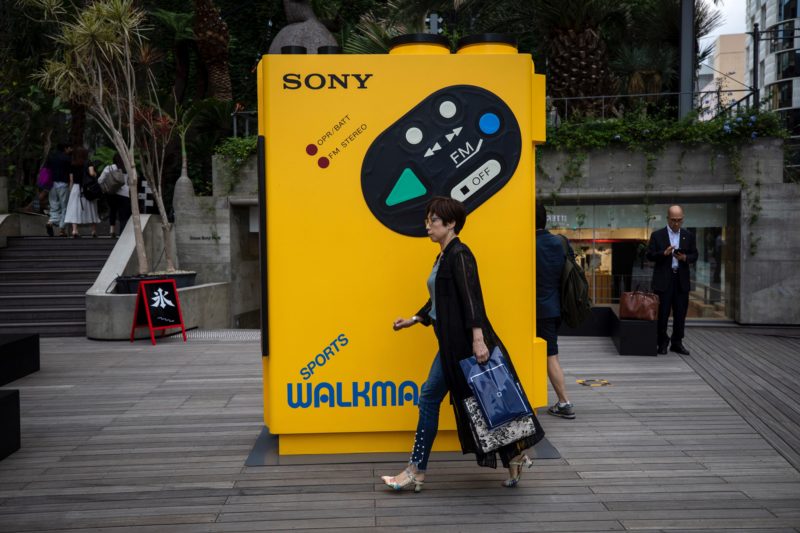Hit rewind: Sony Walkman triggers nostalgia on 40th birthday
Sony has sold more than 420 million ‘Walkmen’ since the first model came out 40 years ago (Behrouz MEHRI)
Tokyo (AFP) – Must-have 80s gadget and one-time icon of Japan electronics cool, Sony’s Walkman turned 40 this year and like its now middle-aged fans, is clinging to its youth with high-tech updates.
On July 1, 1979, as the global economy suffered through the second oil shock, Sony unleashed on the world a dark-blue brick of a machine with chunky silver buttons, the Walkman TPS-L2.
Priced at a hefty 33,000 yen –$300 in today’s money — the first generation Walkman could not record but its stereo music playback function quickly captured hearts in Japan and then the world.
It had two headset jacks — labelled “guys” and “dolls” — to allow two people to listen simultaneously. A bright orange “hotline” button could be pressed to lower the volume while the couple chatted.
After a disappointing first month when only 3,000 units were sold, sales exploded to eventually hit 1.5 million worldwide for the first model. The second model, the WM-2, which came in red, black and silver, chalked up sales of 2.58 million.
Over the following four decades, Sony sold more than 420 million “Walkmen” and stopped counting the number of models it had produced when it hit the 1,000 mark — about 15 years ago.
The Japanese electronics giant chose the name partly because of the popularity of Superman at the time and the fact it was based on an existing audio recorder called the “Pressman.”
The word “Walkman” has since entered everyday language but the device was initially called “Soundabout”, “Stowaway” or “Freestyle” in some parts of the world.
“The Walkman is my youth,” said Katsuya Kumagai, now 51, as he browsed an exhibition to mark the 40th anniversary of the first edition.
“It was always in my life,” he added, scanning some of the 230 varieties of Walkman on show, which also offers nostalgic visitors the chance to play with some of the older models.
As an 11 year old, Kumagai could never afford a Walkman and envied older children as they whizzed by on roller skates plugged into the latest sounds.
“I’m quite emotional. Memories from those days are flooding back,” he said, echoing the thoughts of many a middle-aged fan for whom the Walkman provided the soundtrack to their youth.
– ‘Play and pause’ –
Sony continued production of the cassette-tape Walkman until 2010, long after the technology had been overtaken first by the Compact Disc in the 1980s and the MiniDisc Walkman in 1992.
Like many in the industry, the Japanese firm was shaken by the emergence of Apple’s iPod when suddenly a listener’s entire music collection was available on the move.
But Sony has scrambled to keep up and the latest high-end versions cost well over $2,000 and look more like a smartphone with flash memory and high-res audio — a far cry from the early generations.
Scott Fung, a 17-year-old also attending the exhibition, has never known a time when people could not listen to music on the move and said he had “only heard” about the Walkman and was keen to satisfy his curiosity.
“Ever since I grew up, devices have always had screens and they don’t have physical buttons,” he said clutching his smartphone and gazing at the early Walkmen on display.
“When I was born, Sony Walkman was already not as relevant… (it) was not really a big part of my life,” said the student from Hong Kong who listens to music via his smartphone.
But perhaps surprisingly, he revealed himself to be a fan of the older tech.
“I think this older design is really intelligent where you can just play and pause, go back and forth in a song, which is very interesting to me,” he said.
– ‘It’s so cool’ –
Fung is apparently not alone in his penchant for the old-school technology: a first edition Walkman presented as new and never used sold recently for 1.3 million yen, a mere 40 times its initial price.
Sony engineer Hiroaki Sato, who worked on the early Walkman editions, even said it would be “quite difficult” to replicate the technology now, as it would involve painstakingly reproducing high-precision components.
He said the current versions would likely not exist in 40 years as the recording formats and rechargeable batteries would undoubtedly have changed beyond recognition.
But the old Walkman has stood the test of time.
“Repairing this, I realised this is an excellent machine. If we replace the damaged rubber belt, it works normally. It’s so cool,” he said.
Disclaimer: Validity of the above story is for 7 Days from original date of publishing. Source: AFP.


